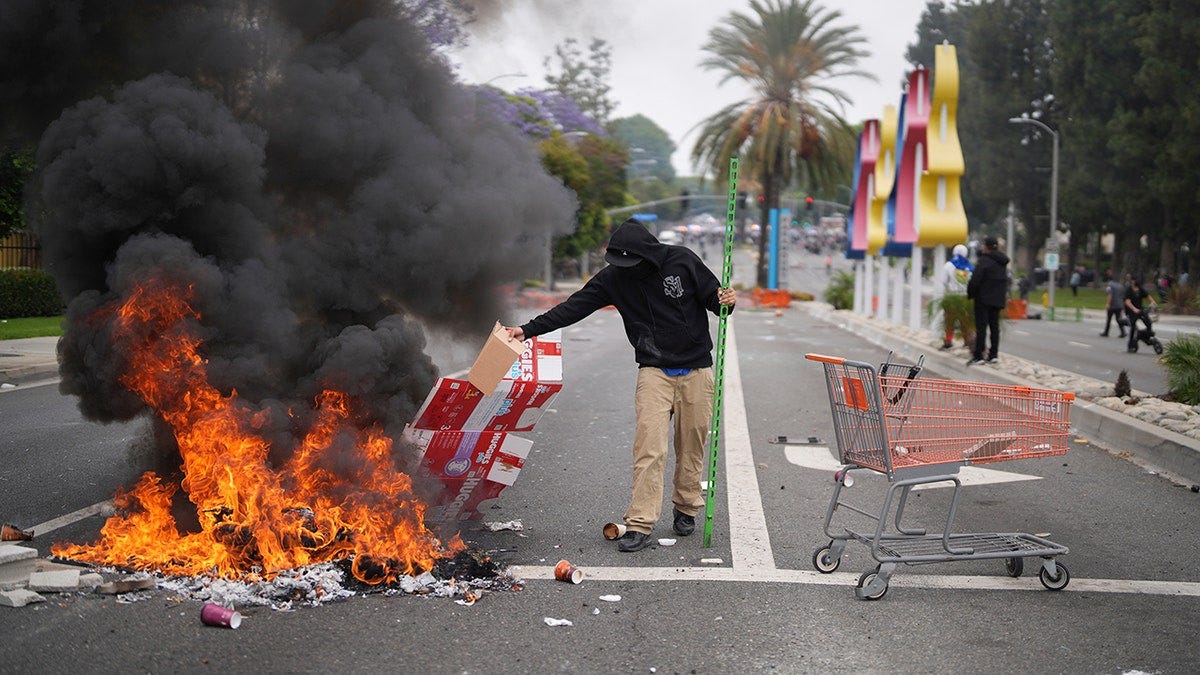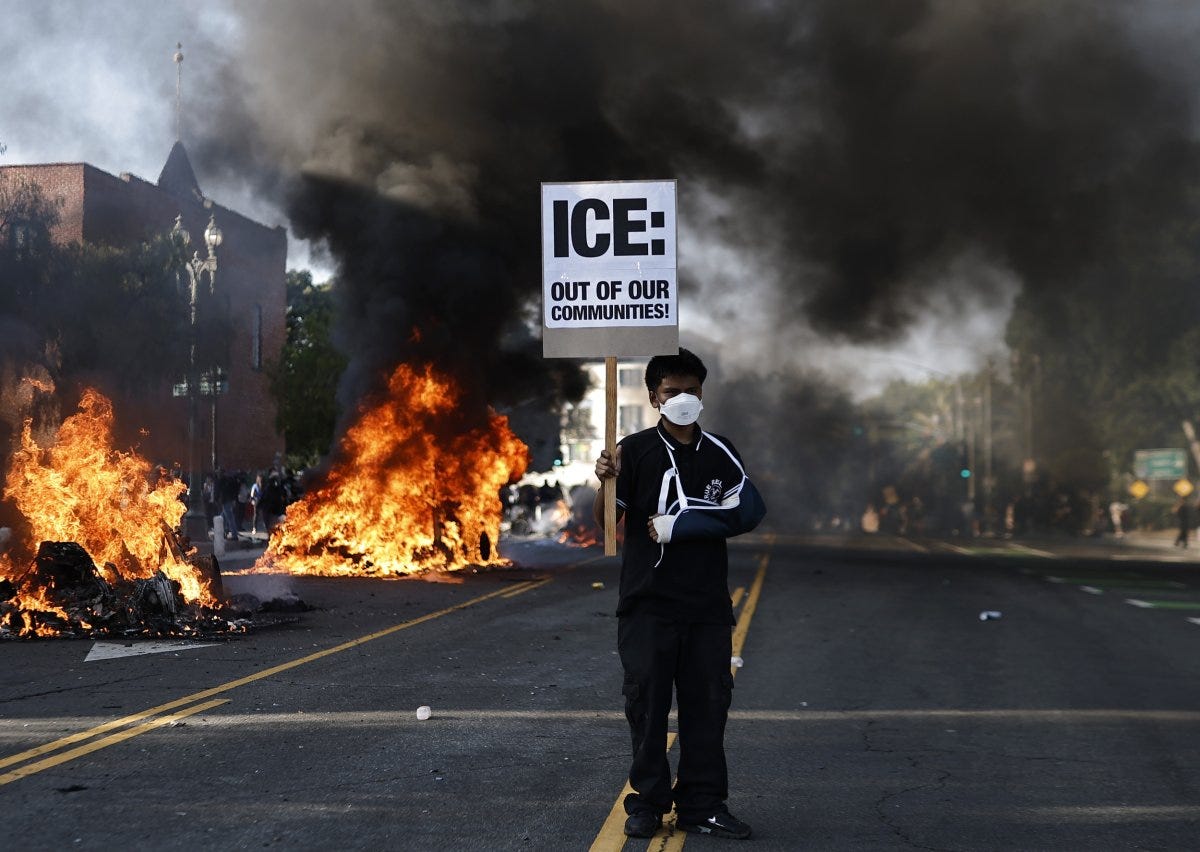Information Warfare's New Paradox: Lessons from the 2025 LA Riots
Welcome to information warfare in 2025. The old rules are dead.

As I write this on June 12, 2025, two versions of Los Angeles exist.
Over the past week, protesters have gathered in downtown Los Angeles following ICE raids conducted in early June. Federal agents in riot gear have faced off against crowds in a five-block area. The confrontation remains real but localized to a small part of the city.
Online, a different story has emerged. Videos show police cars burning and widespread destruction. A TikTok video claiming National Guard troops were preparing to gas civilians reached nearly a million views before CNN and BBC confirmed it was fake.
Much of the dramatic online content has come from recycled 2020 riot footage, action movie clips, and AI-generated videos, according to fact-checkers at the LA Times and Snopes. Real footage of the actual protests also circulates, typically reaching fewer people than the fabricated content.
Information warfare used to flow from the top down. Governments controlled messaging. Media set agendas. You could achieve dominance by controlling key channels and suppressing opposition.
That model no longer works.
The LA riots demonstrate how information warfare has fragmented. Authorities, activists, and random internet users now compete on equal footing to shape public perception in real time.
More participants should mean better information. Sometimes it does. Eyewitness footage revealed police tactics and contradicted official statements. Community fact-checkers flagged fake content within hours.
But participation also creates confusion. When everyone can publish instantly, distinguishing authentic content from fabricated material becomes nearly impossible.
The information environment becomes saturated with competing claims.
The Paradox in Action: LA 2025

The LA riots reveal how the same digital tools create both clarity and confusion simultaneously.
This isn't a bug in the system.
It's the system.
Transparency in Real Time
Eyewitness footage has provided unprecedented access to events as they unfold. Protesters livestream confrontations with federal agents. Bystanders capture police tactics from multiple angles, including controversial uses of force that quickly circulate online and provoke immediate public scrutiny. A news reporter shot with a rubber bullet despite posing no threat became viral evidence of excessive force within hours.
When President Trump and Governor Newsom disputed whether they had spoken by phone, their conflicting accounts played out publicly on social media within hours. Traditional information warfare would have buried such contradictions or controlled their release. Now they happen in real time.
Confusion at Scale
But the same accessibility that enables transparency also floods the information space with fabricated content on platforms like X and TikTok. A viral TikTok video falsely claiming National Guard troops were preparing to gas civilians accumulated nearly a million views before CNN and the LA Times could debunk it. Social media algorithms on both platforms amplify sensational content regardless of accuracy.
A recycled image of burning police cars from 2020 received more engagement than authentic footage of the actual 2025 protests, which remained confined to a small downtown area, as verified by BBC reporting. Platforms prioritize viral potential over truth, creating a distorted perception of events far beyond their actual scale.
Foreign actors have exploited this chaos. Russian and Chinese state media have amplified both real and fabricated images of the unrest, as documented by Reuters, using the situation to criticize American democracy. They operate alongside domestic influencers and ordinary users, making their intervention nearly invisible.
People share content that confirms their existing beliefs without checking sources, accelerating misinformation through echo chambers where false narratives face little challenge.
The Speed Problem
Information now moves faster than verification. False claims about Mexican military intervention in LA garnered millions of views before fact-checkers could respond. People share content that confirms their existing beliefs without checking sources. The cycle of viral misinformation, confirmation bias, and belated correction happens too quickly for most people to follow.
This viral misinformation appears to influence real-world decisions. The exaggerated online narrative of citywide chaos may have contributed to the rapid deployment of National Guard troops, escalating a localized situation into a perceived crisis requiring military intervention.
This creates a permanent state of contested reality. Every claim faces instant challenge. No narrative achieves lasting credibility. The same tools that promise transparency deliver confusion instead.
What This Means

The LA riots offer a preview of how information warfare will operate in every future crisis.
Information Saturation Is the New Normal
We now live in an environment where every event generates multiple competing versions of reality. The LA protests produced thousands of videos, images, and claims within hours. Most people cannot process this volume of information or verify its accuracy.
Traditional gatekeepers like news organizations still exist, but they no longer control the flow of information. They compete with everyone else for attention in an oversaturated market. A carefully reported news article competes directly with AI-generated fakes and recycled footage for the same eyeballs.
This saturation makes decision-making harder, not easier. Officials must respond to crises while sorting through mountains of unverified claims. Citizens must form opinions based on incomplete and contradictory information. The abundance of information creates scarcity of understanding.
The End of Authoritative Truth
No institution can now establish definitive truth about contested events. When the President and a state Governor publicly dispute basic facts like phone conversations, what hope does anyone else have?
The LA riots show how quickly authoritative claims dissolve. Official statements face immediate contradiction from video evidence. Video evidence faces challenges from deepfake accusations. Fact-checks face accusations of bias. Every source of authority has become contestable.
This doesn't mean truth doesn't exist. It means that establishing shared agreement about truth has become nearly impossible. The mechanisms that once created consensus have broken down.
Living in Contested Reality
We are adapting to a world where every significant event generates multiple incompatible narratives that persist simultaneously. People choose which version of reality to inhabit based on their existing beliefs and trusted sources.
The LA riots demonstrate this clearly. Some people experienced them as justified protests against immigration enforcement. Others saw them as violent riots requiring military intervention. Both groups had video evidence supporting their interpretation.
This fragmentation affects everything from crisis response to democratic governance. How do you make collective decisions when citizens cannot agree on basic facts? How do you respond to emergencies when every action faces immediate contest?
The fragmented information warfare landscape doesn't just change how we fight wars of words.
It changes how we understand reality itself.





